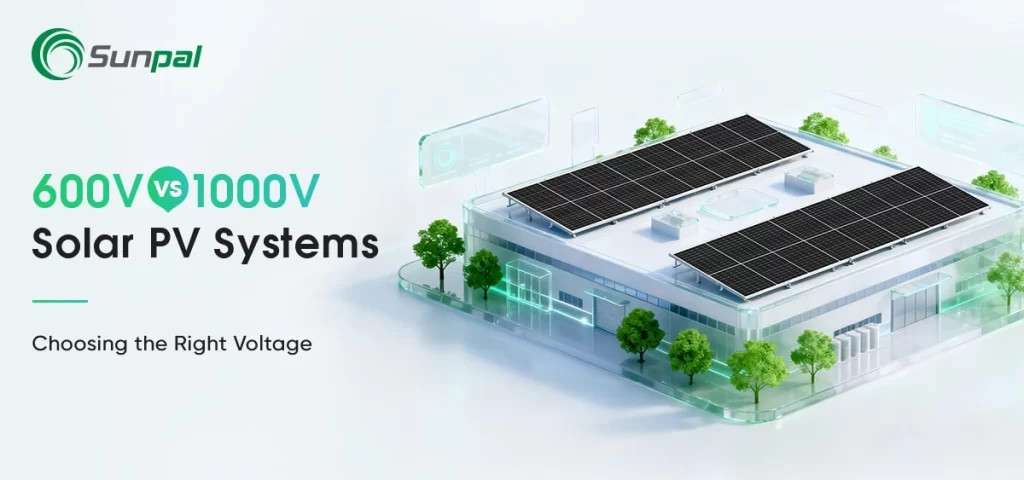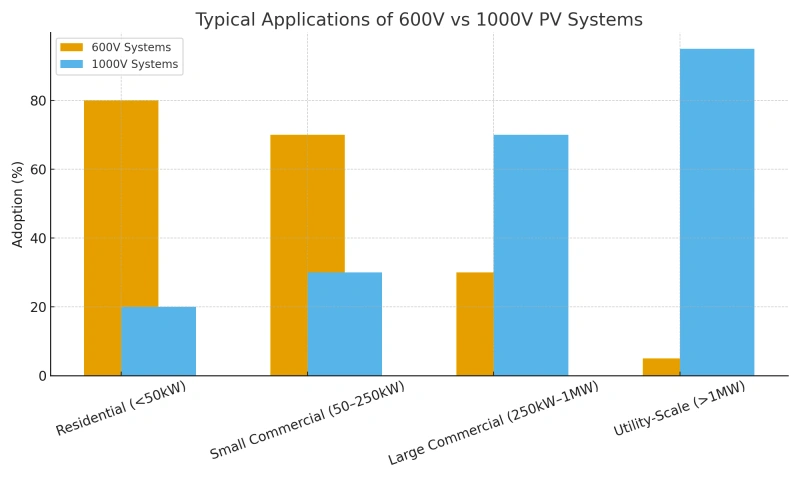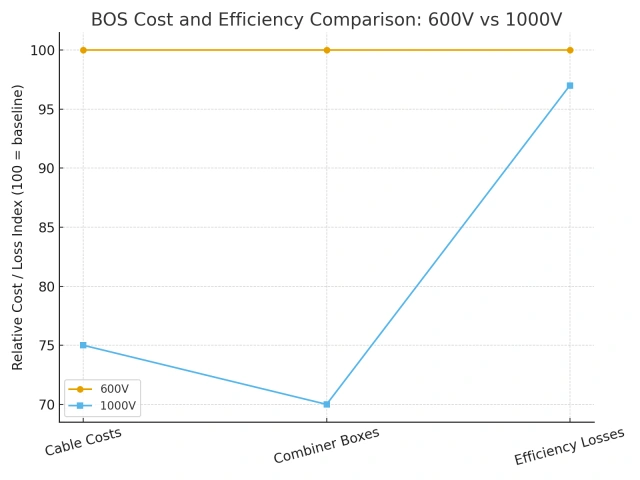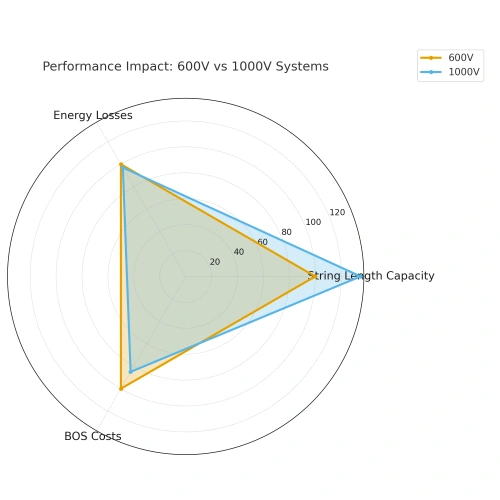
The voltage configuration of a solar PV system is more than a technical detail—it's a decision that shapes efficiency, safety, installation costs, and long-term returns. Across the global solar energy industry, businesses and developers face the ongoing choice: should a project be built using a 600V solar PV system or a 1000V solar system?
With rising demand for commercial solar installations and utility-scale renewable energy projects, this question has become central to project planning. In this article, we break down the differences, explore real-world cost impacts, and look ahead to how voltage standards are evolving.
Why Voltage Matters in Solar PV Design
In simple terms, the system voltage determines how many panneaux solaires can be connected in a string and how much current flows through the wires.
- A 600V PV system has traditionally been the standard for residential solar power systems and small commercial installations.
- A 1000V solar PV system allows longer strings, reducing wiring complexity, lowering balance of system (BOS) costs, and improving efficiency.
The difference isn't minor. Choosing between 600V vs 1000V configurations directly affects:
- Project scale (how big the system can get)
- Installation costs (wiring, combiner boxes, labor)
- Compliance and safety standards
- Long-term performance and ROI
Understanding 600V and 1000V Configurations
600V Solar Systems
- Widely used in residential solar arrays and smaller commercial projects.
- Simpler to design and maintain.
- Compatible with most inverters and panels available on the market.
1000V Solar Systems
- Primarily adopted in large commercial and utility-scale solar farms.
- Longer strings reduce the number of combiner boxes and cables.
- Lower current improves system efficiency.
Chart 1: Typical Applications of 600V vs 1000V PV Systems

As the chart shows, 600V dominates residential installations, while 1000V is favored in commercial and utility-scale projects where efficiency and scalability matter most.
Efficiency Gains and BOS Cost Savings
One of the strongest arguments for 1000V systems is their ability to reduce system losses and installation costs.
- Longer string capacity means fewer combiner boxes and shorter cable runs.
- Lower current flow reduces resistive losses in conductors.
- BOS savings can reach 10–15%, a significant factor in large-scale solar power plants.
Chart 2: BOS Cost and Efficiency Comparison

- Cable costs drop by up to 25%.
- Combiner box requirements decrease by 20–30%.
- Energy efficiency improves by 1–2%, which translates to major gains over a system's 25-year lifetime.
For a 50MW solar farm, these improvements can mean millions in savings and higher long-term profitability.
600V Systems: Advantages and Challenges
Advantages of 600V PV Systems:
- Perfect fit for residential and small commercial projects.
- Straightforward compliance with local electrical codes.
- Wide compatibility with mainstream solar inverters and modules.
- Lower upfront equipment costs, making them attractive for homeowners.
Challenges:
- Limited string length increases the need for more cables and BOS components.
- Less efficient in projects above 250kW.
- Being gradually phased out in large-scale commercial and utility projects.
Example: A 50kW commercial rooftop installation typically benefits from 600V because it requires simpler wiring and avoids unnecessary complexity.
1000V Systems: Advantages and Trade-Offs
Advantages of 1000V PV Systems:
- Longer string capacity reduces connections and BOS hardware.
- Higher voltage improves energy yield and system efficiency.
- Ideal for large commercial rooftops and utility solar farms.
- Labor savings due to fewer connection points.
Trade-Offs:
- May require enhanced safety protocols during installation.
- Not always cost-effective for smaller systems under 100kW.
- Requires engineers with high-voltage design expertise.
Chart 3: Performance Impact – 600V vs 1000V Systems

The chart illustrates how 1000V systems outperform 600V systems in string length (+35%), BOS costs (-15%), and energy loss reduction (~3%).
Key Factors in Choosing Between 600V and 1000V
The decision should be based on a comprehensive analysis of project needs. Factors include:
Project Scale
- 600V suits homes and small businesses.
- 1000V suits commercial, industrial, and utility-scale installations.
Local Regulations
- Some regions limit residential systems to 600V for safety.
- Utility codes often mandate higher-voltage systems for efficiency.
Budget and ROI
- 600V may have lower upfront costs but higher BOS expenses.
- 1000V delivers better lifetime ROI due to reduced operational costs.
Future Expansion
- Developers planning for expansion often prefer 1000V because it allows scalable design without major retrofits.
Case Study Comparison: Residential vs Utility
Residential Rooftop (10kW, 600V)
- Simple design.
- Quick installation.
- BOS costs are manageable at small scale.
Utility Solar Farm (50MW, 1000V)
- Reduces BOS by over $1M in cabling and combiner boxes.
- Improves efficiency enough to power hundreds of additional homes annually.
- Better suited for long-term operation and grid integration.
This contrast highlights why system size drives the voltage decision.
Industry Trends: From 600V to 1000V and Beyond
The global solar industry is steadily shifting toward higher-voltage configurations.
- 600V remains standard in residential solar markets.
- 1000V is now the norm for commercial and industrial PV systems.
- 1500V systems are emerging as the dominant choice for mega utility-scale solar projects, cutting BOS costs by an additional 20% compared to 1000V.
This transition reflects a broader trend: as solar technology evolves, higher voltages deliver greater efficiency, lower costs, and improved scalability. Manufacturers are already optimizing modules and inverters for 1500V, ensuring compatibility for future projects.
Conclusion: Making the Smart Voltage Choice
The 600V vs 1000V solar PV system decision is not one-size-fits-all.
- 600V remains reliable and cost-effective for homes and small commercial projects.
- 1000V offers efficiency and BOS savings for large-scale and utility projects.
- 1500V is shaping the future of solar PV, especially in utility-scale installations.
Ultimately, the right choice depends on scale, compliance, and financial goals. By carefully evaluating these factors, developers can align voltage selection with project success.
Call-to-Action
At Sunpal Solar, we provide expert guidance on solar PV system design, inverter selection, and voltage configuration. Whether you're a homeowner, business, or utility developer, our team delivers tailored solar solutions that maximize efficiency, cut costs, and future-proof your energy investment.
Contact Sunpal Solar today to find out which voltage system is right for your project.
